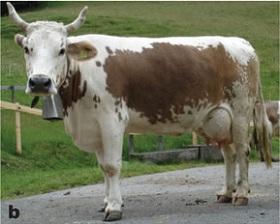Using AI to control energy for indoor agriculture
30 September 2024
Published online 17 April 2012

A colour pattern in domesticated cattle is caused by a mutational mechanism in which gene fragments are shuttled from one chromosome to another, according to research published in Nature.
Colour sidedness is an inherited colour pattern characterised by a white band along the back, and pigmented areas towards the flanks as well as ears, snout and tail.
An international team of researchers, led by Keith Durkin of the University of Liège, Belgium, and including Aynalem Haile of the International Center for Agricultural Research in the Dry Areas (ICARDA) in Aleppo, Syria, scanned the genomes of colour sided Belgian blue and brown Swiss cows for shared combinations of gene variants, and compared them to control animals.
Colour sidedness is determined by two genetic variants located respectively on chromosome 29 for Belgian blue and 6 for brown Swiss cows, according DNA sequencing of the genes involved revealed how the variation is generated.
One of the variants is in the LUZP2 gene on chromosome 29. The gene is interrupted by a large fragment of DNA containing the KIT gene, which is excised from chromosome 6.
The other variant is derived from the first one by excision of a fragment DNA containing chromosome 6 and 29 sequences, including a segment of the LUZP2 gene, which is shuttled back to chromosome 6.
The researchers confirmed these findings by analysing DNA from seven other breeds of cattle breeds and domesticated yaks, and found the same variants in all of them, suggesting that the two genes identified probably account for colour sidedness in most, if not all, cattle.
The unusual coat colour pattern is thought to result from dysregulation of the KIT gene, which is known to be critical for the survival and migration of melanocyte cells, which produce the pigment melanin, during embryonic development.
It's still unclear whether the novel serial translocation process identified in the study is unique to cattle. In humans, the mechanism may contribute to the mutations that make cells cancerous, and the researchers have identified a large number of sites in the human genome where this may have occurred.
"We are now trying to find further evidence for the occurence of similar events in humans and other species," says Michel Georges, a senior author of the study.
doi:10.1038/nmiddleeast.2012.56
Stay connected: